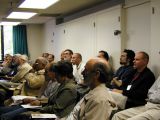|
HEINZ BAUSCHKE, University
of Guelph
Asymptotic behaviour of the
composition of two resolvents
Consider the problem of finding a point in the intersection
of two nonempty closed convex sets in a Hilbert space. The method of
alternating projections is an iterative attempt to solve this problem. If
the intersection of the two sets is nonempty, then-this is a classical
result due to Bregman-the sequence generated converges weakly to a common
point; otherwise, the sequence either tends to infinity in norm or it
possesses two cluster points realizing the gap between the two sets.
In this talk, I will discuss recent extensions of this
result concerning the asymptotic behaviour of resolvents and Bregman
proximal maps. (Based on joint work with Patrick Combettes (Paris
6), Dominikus Noll (Toulouse),
and Simeon Reich (Technion).)
GRAHAME BENNETT, Indiana
University, Bloomington, Indiana
Summability
for those without
We consider several attractive and easy-to-state problems.
These have no apparent connection with Summability Theory, yet their
solutions are all centered upon one of David Borwein's favorite topics:
Hausdorff matrices.
PETER BORWEIN, Simon
Fraser University
Three Highly Computational
Problems in Number Theory
A
number of classical and not so classical problems in number theory
concern finding polynomials with integer coefficients that are small in
some norm. These include old chestnuts like the Merit Factor Problem of
Golay, Lehmer's Conjecture and Littlewood's (other) Conjecture.
PETER CASS, University of Western
Ontario (and JONATHAN BORWEIN,
Dalhousie),
A Retrospective
on David Borwein's Contribution to Mathematical Research and David and Me (a 1971 ms)
MICHAEL OVERTON, Courant Institute of Mathematical Sciences,
NYU
Optimal
Stability and Eigenvalue Multiplicity
We consider the problem of minimizing over an affine set of
square matrices the maximum of the real parts of the eigenvalues. Such
problems are prototypical in robust control and stability analysis. Under
nondegeneracy conditions, we show that the multiplicities of the active
eigenvalues at a critical matrix remain unchanged under small
perturbations of the problem. Furthermore, each distinct active
eigenvalue corresponds to a single Jordan
block. This behavior is crucial for optimality conditions and numerical
methods. Our techniques blend nonsmooth optimization and matrix analysis.
(This is joint work with James V. Burke (U. Wash.) and Adrian
S. Lewis (SFU).)
BRUCE SHAWYER, Memorial University
of Newfoundland
A Tribute and A Plethora of Remarkable Concurrences
This
talk is in two parts:
1. An appreciation of David Borwein
as a colleague, problem solver, supervisor and person.
2. A Plethora of Remarkable
Concurrences, dedicated to David Borwein on his 80th birthday.
There
are several examples of concurrence in classical triangle geometry. For
example, the medians, the altitudes, the angle bisectors and the
perpendicular bisectors of the sides. Here we show that there is a
plethora of concurrences with some remarkable properties.
BRUCE WATSON, Memorial
University of Newfoundland
Discrete Power
Series Methods
In
1989 and 1990 papers, Maddox and Armitage discretized the well-known
Cesàro and Abel methods. The author extends the definitions to discrete
power series and weighted mean methods and gives some abelian and
tauberian results.
JIM ZHU, Western Michigan
University, Kalamazoo.
A
variational proof of Birkhoff's theorem on doubly stochastic matrices
I will give a short and self-contained variational proof of
Birkhoff's theorem asserting that the extreme points of the convex set of
doubly stochastic matrices are the permutation matrices.
|


